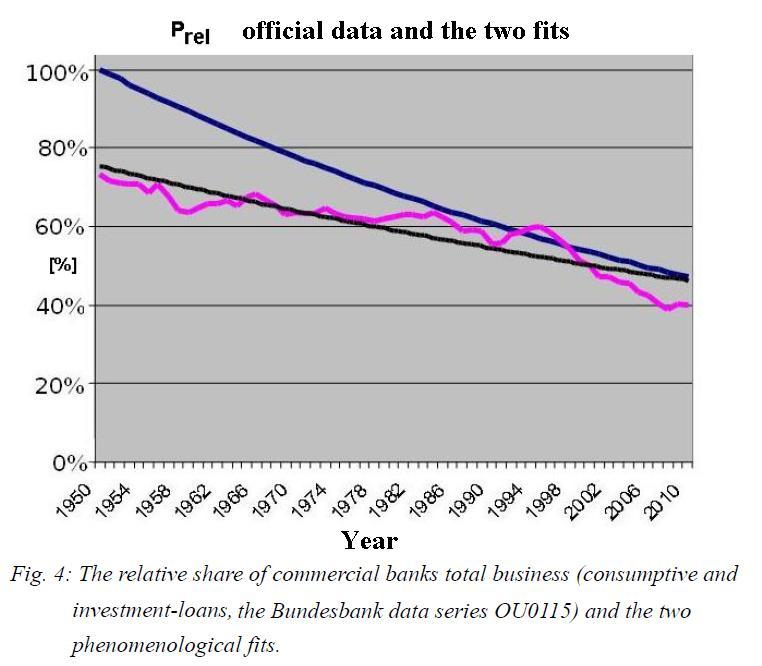7 Determination of the Net Business Rate
For the formulation of the net business rate ![]() we need a
statement about the ratio of investment into the real economy to the transactions
of the financial system to itself, that means the relation between direct and
indirect investment. Let us consider again the differential equation of
capital:
we need a
statement about the ratio of investment into the real economy to the transactions
of the financial system to itself, that means the relation between direct and
indirect investment. Let us consider again the differential equation of
capital:![]() . The coefficient
. The coefficient
![]() is the effective
interest on the capital this year. This interest stems from the two
components of direct and indirect use of capital. So we can split to:
is the effective
interest on the capital this year. This interest stems from the two
components of direct and indirect use of capital. So we can split to:
![]() (7.1)
(7.1)
Because the share of capital stock which is
sold within the financial industry immediately gains returns. The proportion
which is given initially in the real economy reduces the capital stock this
year and receives its return later, presumable next year. The interest rates ![]() however can also
be different. With the simple substitutio
however can also
be different. With the simple substitutio![]() we
get now:
we
get now:
![]() (7.2)
(7.2)
So we have to carry two blocks from the income and expenditure which is the overall result. But we can summarize this flat in one rate by
![]() (7.3)
(7.3)
defined as the difference between the results
of expenditure and revenue. With ![]() then
as the average nominal interest rate on all types of assets. And the proportion
who fail this year due to the credit of it is
then
as the average nominal interest rate on all types of assets. And the proportion
who fail this year due to the credit of it is ![]() .
This approach simplifies calculations thereafter significantly. Next we define
the relative value
.
This approach simplifies calculations thereafter significantly. Next we define
the relative value ![]() as the share
which represents the direct use of capital to total capital stock:
as the share
which represents the direct use of capital to total capital stock:
![]() (7.4)
(7.4)
This value was in 1950, two years after the introduction of the German mark, according to figures from the Bundesbank14 at about 73% and decreased continuously to less than 40% in 2010. This can be phenomenologically explained by the fact that at the beginning15 of an economy the capital is available to virtually all loans (investment and consumptive) as flows into the real economy. With increasing time and thus increasing capital stock, more and more money goes into the banks own business (the "Investment Banking"), as the yield-oriented investments get more and more scarce in the real economy over time.
Since we now have to specify the relative
proportion not absolute, but as a percentage of total interest income in our
equation, we write this value to something different: ![]() is the share of
interest income
is the share of
interest income ![]() that comes from
lending into the real economy as an absolute part of a percentage. Thus applies
to the net business ratio16
that comes from
lending into the real economy as an absolute part of a percentage. Thus applies
to the net business ratio16 ![]() after
the reinvestment of
after
the reinvestment of ![]() to the GDP now in
terms of
to the GDP now in
terms of![]() as:
as:
![]() (7.5)
(7.5)
If we look at the real data of![]() (Fig. 4), then we
see its regular course. We can start with a simple phenomenological17 approximation, namely that the
share of reinvestment decreases slowly according to a simple exponential form:
(Fig. 4), then we
see its regular course. We can start with a simple phenomenological17 approximation, namely that the
share of reinvestment decreases slowly according to a simple exponential form:
![]() (7.6)
(7.6)
As is easily seen, this function starts (![]() ) with the value
) with the value ![]() . After the
exponential half-lifetime18
. After the
exponential half-lifetime18![]() it falls off to
it falls off to ![]() and then very
slowly goes towards zero. Our formula is therefore justified phenomenologically
as
and then very
slowly goes towards zero. Our formula is therefore justified phenomenologically
as
![]() (7.7)
with
(7.7)
with
![]() average nominal
interest rate over all assets
average nominal
interest rate over all assets
![]() Initial direct
capital investment as a share of total capital stock
Initial direct
capital investment as a share of total capital stock

![]() The period after the direct capital investment has dropped to about 1/e=36.7%
(exponential half-lifetime). In order to eliminate the specific initial
parameter
The period after the direct capital investment has dropped to about 1/e=36.7%
(exponential half-lifetime). In order to eliminate the specific initial
parameter ![]() and in the
interest of generality and a purely phenomenological analytical consideration,
it can be assumed that at the beginning of an economy almost 100% of the
capital is used for the loans to finance the real economy (upper fit curve).
and in the
interest of generality and a purely phenomenological analytical consideration,
it can be assumed that at the beginning of an economy almost 100% of the
capital is used for the loans to finance the real economy (upper fit curve).